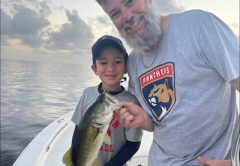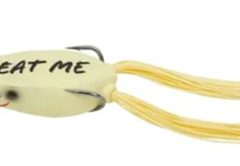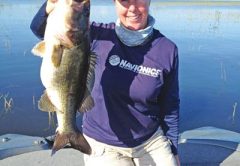Snook season is here and it starts with lure selection. Yes, the lures you choose for Snook fishing should be determined by where you fish. If I am fishing in the canals first thing in the morning as the sun is just coming up, I am using a Zara Spook. The Spook is a top water lure when reeled in and twitched at the same time causes the front of the lure to slash side to side. Most anglers call this technique ‘walking the dog’. Pick a place and cast the Spook within a foot of the sea wall. Go over the spot at least 3 times, if you don’t get a hit, turn and cast the other way up the sea wall at least three times. I will repeat this casting one way and then the other at least twice before I move and when I move it is 10 feet farther away, and then do the same thing again.
Now if I am casting from a pier, I will choose a B15A Bomber or a Rapala X-rap 10. I start casting as soon as I get on the pier. OK, as soon as there is 10 inches of water or more. Snook are a shallow water fish. Once on the pier I start on the right side of the pier casting along the length of the pier going out. I try to be as close to the pilings as possible so my lure will just brush the outside of the pilings. Snook hangout on the back side of the pilings waiting for food to come by. So if I cast along the side of the pier I can get the lure to go by four sets of pilings. This gives me the best shot at getting my lure in front of the Snook’s nose. I will cast from one spot four times then move half a cast farther out onto the pier.
Now if I don’t feel like pulling up a lawn chair and soaking a bait on the bottom, nor do I feel like casting a lure, I’ll take a live shrimp for a walk down the pier. I start by getting a little larger sized shrimp and a jig head. This is the time for a heavier jig head like a 3/8 or ½ oz. or heavier. The job of the jig head is to keep the line straight up and down. Then I hook the live shrimp from the bottom of the head and out the top of the shrimp’s head leaving the body trail out behind the jig head. Once rigged I don’t cast the jig, I put my right arm over the rail, open up my reel’s bail and let the jig head and live shrimp free-fall to the bottom.
Once the jig and shrimp are on the bottom, I close the bail, take up any slack in the line and lift my rod tip up six inches. Then I start to slowly walk farther out onto the pier. If it’s a wood pier I step on each board as I walk out, on a concrete pier I use half steps. Slow and quiet is the key to catching Snook this way. Have the drag on the reel set to “locked down” so when the Snook hits, the whole fight will be right at your feet. Snook are notorious for wrapping fishermen’s lines around pilings or finding every sharp barnacle in sight, so show Mr. Snook no mercy. This is not the time to finesse the fish or play him out, get his head out of the water as soon as possible. Once you get his head out of the water then you need to lift him onto the pier. This requires having a pier net which are ring nets with long strong ropes to lower the net to the water. This is usually a two person job. Lower the net to the fish and get the net under the fish or slide the fish into the net or a combination of both. The key is to keep the Snook’s head above water. Lowering his head back into the water opens up the possibility of another last ditch run to freedom. Once you get your Snook onto the pier and he is outside the slot and has to be returned to the water, use your net to lower him back into the water. Don’t throw the fish over the pier rail and allowing him to fall back into the water. This will most likely harm or kill the fish, so lower him in the net back into the water so he can live to fight another day.
Out on the flats I like to use paddle-tail jigs or the soft plastic jerk baits to cast up under the mangrove bushes. A jerk bait with a weedless hook works better since the hook is not exposed making it harder to get it snagged on a branch or root. Mastering the technique of ‘skip’ casting, which consists of skipping your bait under the limbs of the overhanging mangrove bushes, will greatly improve your chances of getting your bait into the Snook’s strike zone. It’s just like skipping stones across the water when you were young, it’s a matter of speed and the angle of the cast.
On the open flats, paddle-tailed shads like the D.O.A. Cal Shad are the lures of choice and should be retrieved with an up and down jigging motion to the rod. The lifting and dropping of the rod tip makes the lure do the same thing. Picture a bait fish being chased out of the grass towards the surface then going back down to hide only to be chased up again.
Now the #1 Snook lure is the Storm Twitch. This is a crank bait that can be reeled in with a slow and steady retrieve or twitched. If you stop/pause the lure during the retrieve, this will drive Snook crazy. In Coral Creek and Lemon Bay the Storm Twitch has out fished everything. I don’t know why but the Storm Twitch has the same effect on the beaches.
Fishing the beaches of the barrier islands is relatively simple for Snook. Wade out to knee deep water, turn left or right as you prefer, and cast and retrieve slowly or with light twitches. Keep the bait or lure in knee deep water and hang onto the rod. There are some monster Snook right on the beach.
Snook is the year round inshore big game fish of Florida. They can be caught at almost any time of the year, anywhere there is structure, and even on the near shore reefs. As you go further south on the west coast, some of the best Snook fishing is on the reefs within a couple miles of shore and it is not uncommon to find Snook over 40 inches on the reefs in the Gulf.
Just remember for west coast Snook, the fall season runs from September 1st through November 30th, the slot limit for west coast snook is not less than 28-inches and not more than 33-inches (total length) and the creel limit is 1 per day.
Good luck
Fishin’ Frank
[easy-social-share]






